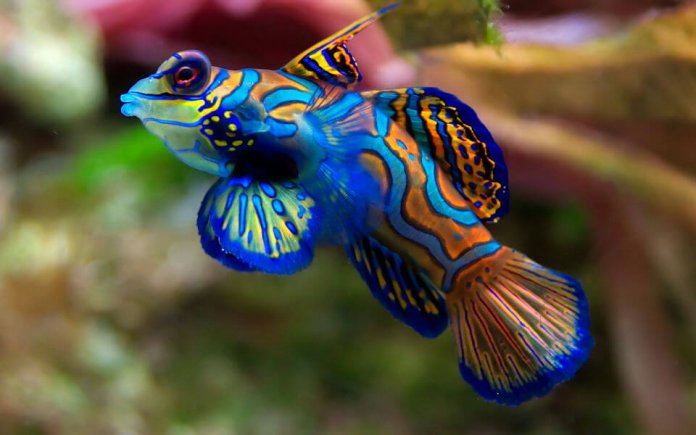Despite the subjectivity of the perception of beauty, there are things that cannot be looked at without admiration. This includes the underwater world. The beauty and uniqueness of some representatives of the Underwater Kingdom is amazing. But what is most striking is the great variety of the most beautiful fish in the world. Today we present a photo and description of the beautiful representatives of the ichthyofauna.
20. Royal centropig
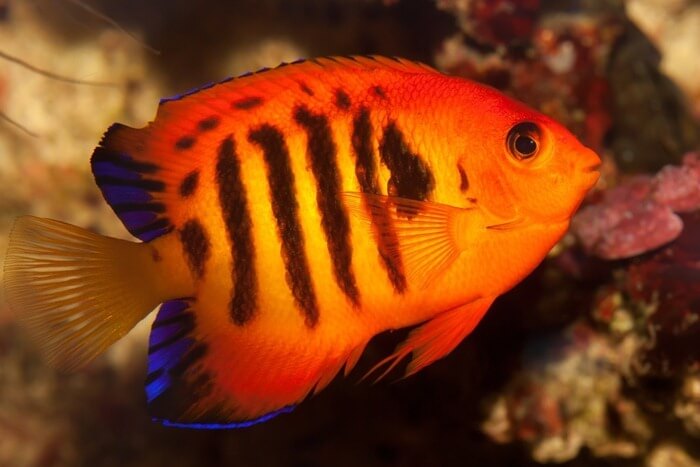 The Royal Centropig, which is also called the Fiery Centropig, combines enviable endurance and bright colors. It looks more than spectacular in aquariums and generally adapts easily to the built environment. In nature, the centropig prefers lagoons with clear water and reef slopes. Inhabits the Central and Western Pacific, less common in Indonesia.
The Royal Centropig, which is also called the Fiery Centropig, combines enviable endurance and bright colors. It looks more than spectacular in aquariums and generally adapts easily to the built environment. In nature, the centropig prefers lagoons with clear water and reef slopes. Inhabits the Central and Western Pacific, less common in Indonesia.
19. Angel lyrebird decorated
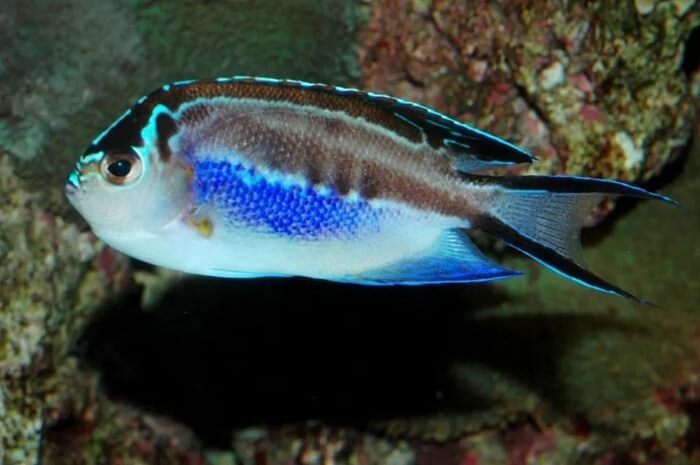 This "angelic" fish is quite whimsical to care for: for a normal existence in the aquarium environment, it needs a large space, always clean water, pebbles and special food. The lyrebird angel is rarely found in Russia due to the high price. The name of this fish is due to its structure: the body is elongated, and the tail is lyre-shaped.
This "angelic" fish is quite whimsical to care for: for a normal existence in the aquarium environment, it needs a large space, always clean water, pebbles and special food. The lyrebird angel is rarely found in Russia due to the high price. The name of this fish is due to its structure: the body is elongated, and the tail is lyre-shaped.
18. Royal Angelfish
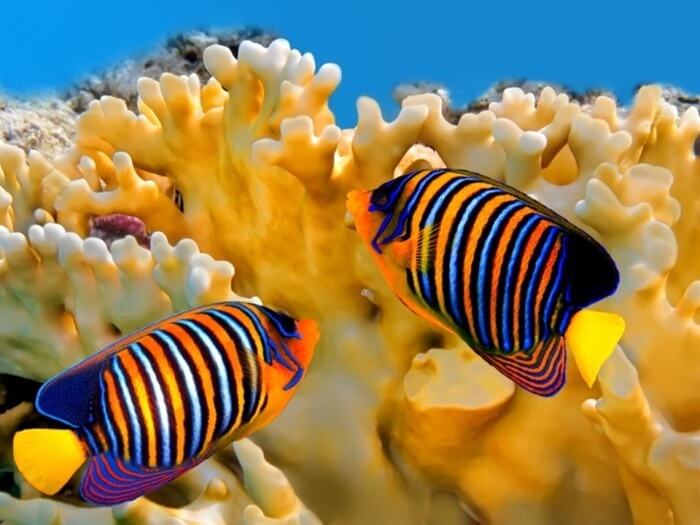 Angel fish is an elegant and beautiful name for a fish, and it itself attracts the eye with its beauty. Although she loves to stay in the shadows, her beautiful outlines and extraordinary coloring are hard to miss and appreciate. This is a rather capricious fish: it loves a lot of space, it is hard to endure being in captivity, and also prefers loneliness and solitude. Even if there are hundreds of fish in the aquarium, the angel fish can be seen immediately, by its flat body with large bright stripes.
Angel fish is an elegant and beautiful name for a fish, and it itself attracts the eye with its beauty. Although she loves to stay in the shadows, her beautiful outlines and extraordinary coloring are hard to miss and appreciate. This is a rather capricious fish: it loves a lot of space, it is hard to endure being in captivity, and also prefers loneliness and solitude. Even if there are hundreds of fish in the aquarium, the angel fish can be seen immediately, by its flat body with large bright stripes.
17. Radiant lionfish
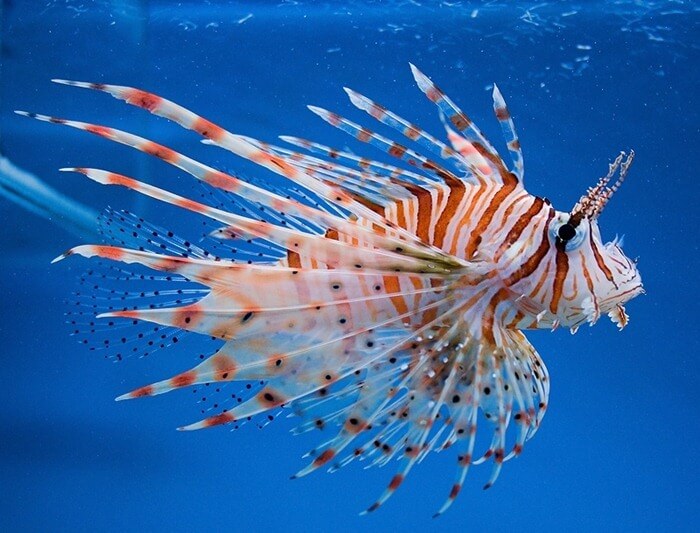 The radiant lionfish is one of the most unusual and spectacular fish. Her body has a pretentious shape and a specific cover. The color is pale red, brown and black vertical stripes. But the main feature is that its dorsal fin has more than a dozen poisonous rays, an injection of which can be fatal. These rays are interconnected by a pinkish-brown membrane, therefore, when moving, this fish resembles a fiery flame.
The radiant lionfish is one of the most unusual and spectacular fish. Her body has a pretentious shape and a specific cover. The color is pale red, brown and black vertical stripes. But the main feature is that its dorsal fin has more than a dozen poisonous rays, an injection of which can be fatal. These rays are interconnected by a pinkish-brown membrane, therefore, when moving, this fish resembles a fiery flame.
16. Moorish idol
 The Moorish Idol is a very beautiful and graceful fish. One cannot but agree that this particular type of fish is familiar to each of us from childhood: the image of the Mauritanian idol is often found both in the visual arts and in everyday life (for example, on the curtains in the bathroom, kitchen potholders, etc.). Of course, poachers did not bypass this species as well, which put it on the brink of extinction. That is why the idol is practically not found in aquariums.
The Moorish Idol is a very beautiful and graceful fish. One cannot but agree that this particular type of fish is familiar to each of us from childhood: the image of the Mauritanian idol is often found both in the visual arts and in everyday life (for example, on the curtains in the bathroom, kitchen potholders, etc.). Of course, poachers did not bypass this species as well, which put it on the brink of extinction. That is why the idol is practically not found in aquariums.
15. Mandarin duck
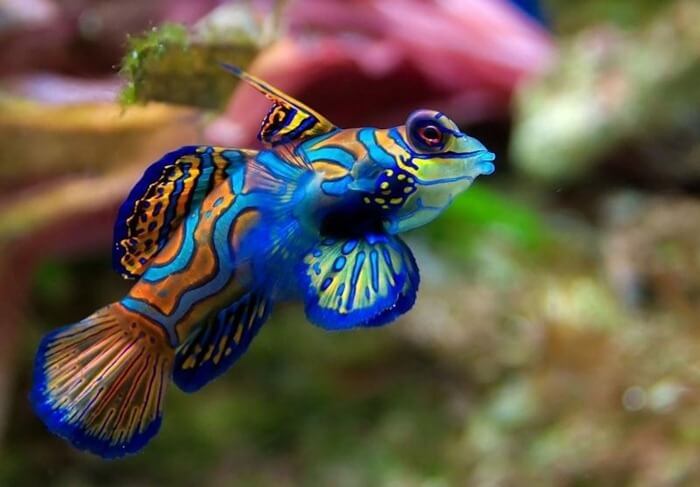 These fish are also called rainbow beauties. They are characterized by a bright color, which is absolutely unique for each individual. All the colors of the rainbow belong to the main colors "used" in their wearable design.All of them form unusual and intricate "pictures" on the body of the fish.
These fish are also called rainbow beauties. They are characterized by a bright color, which is absolutely unique for each individual. All the colors of the rainbow belong to the main colors "used" in their wearable design.All of them form unusual and intricate "pictures" on the body of the fish.
14. Spinhorn Picasso rectangular
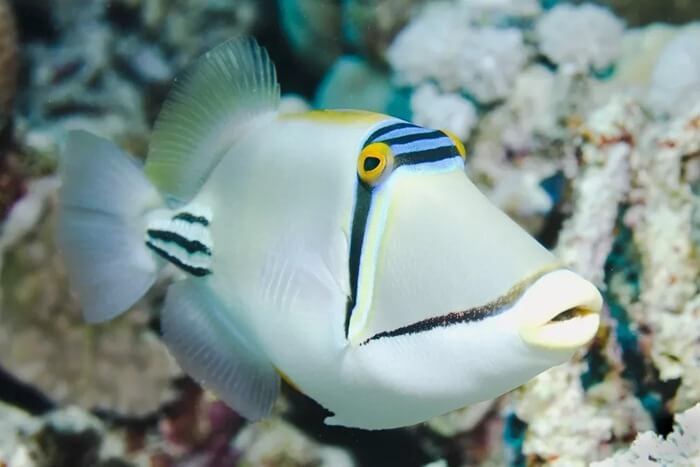 This very large fish often reaches up to 30 centimeters in length and is an excellent decoration for large panoramic aquariums. The main feature of the triggerfish is its eyes, which rotate independently of each other.
This very large fish often reaches up to 30 centimeters in length and is an excellent decoration for large panoramic aquariums. The main feature of the triggerfish is its eyes, which rotate independently of each other.
13. Blue royal surgeon
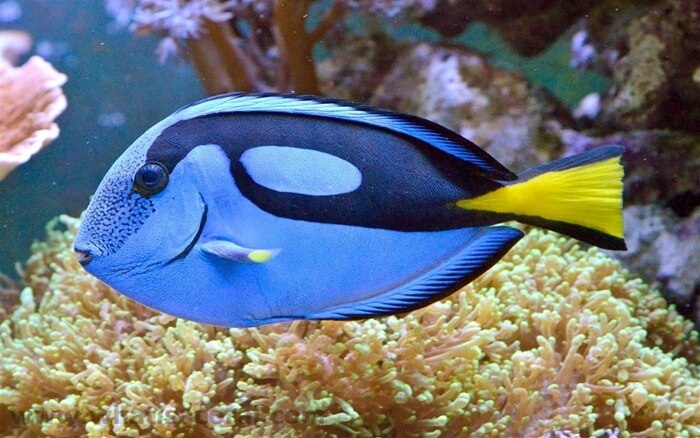 We all remember and love the cartoon "Finding Nemo". It was after its release that this type of fish became so popular. A character named Dory was a blue royal surgeon. This fish is also renowned for its vibrant color: a catchy combination of blue-violet and bright yellow colors. "Surgeons" prefer to hide in the crevices of sea reefs, where they hide from predators, and also find food in the form of algae.
We all remember and love the cartoon "Finding Nemo". It was after its release that this type of fish became so popular. A character named Dory was a blue royal surgeon. This fish is also renowned for its vibrant color: a catchy combination of blue-violet and bright yellow colors. "Surgeons" prefer to hide in the crevices of sea reefs, where they hide from predators, and also find food in the form of algae.
12. Six-lane wrasse
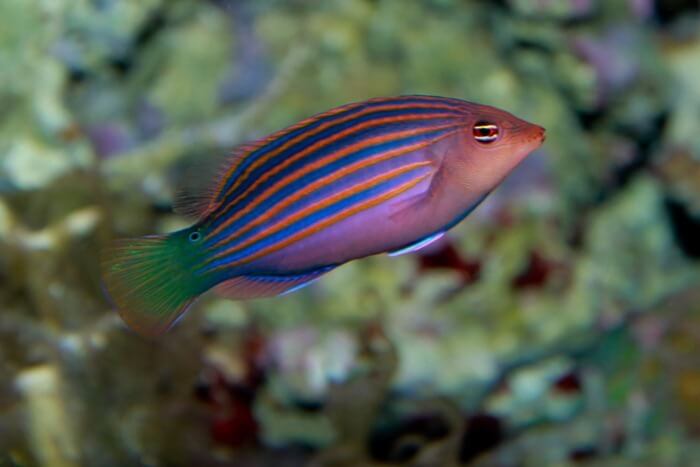 The six-striped wrasse, or wrasse-tansy, as it is also called, got its name from the six bright horizontal stripes on the sides. This species of fish rarely reaches 7 centimeters in length, leads a diurnal lifestyle, while living in the very depths, burrowing into sand and loose soil. One of the natural properties of the six-striped wrasse is the destruction of harmful molluscs.
The six-striped wrasse, or wrasse-tansy, as it is also called, got its name from the six bright horizontal stripes on the sides. This species of fish rarely reaches 7 centimeters in length, leads a diurnal lifestyle, while living in the very depths, burrowing into sand and loose soil. One of the natural properties of the six-striped wrasse is the destruction of harmful molluscs.
11. Tetraodon
 Tetraodons can be counted among the most controversial and unpredictable inhabitants of the aquarium. Outwardly, they are very cute: they have smooth skin, large round and humanly trusting eyes, a rounded body. But in reality, they are poisonous and dangerous predators, which with their sharp and strong four teeth crush the ridges and fins of fish.
Tetraodons can be counted among the most controversial and unpredictable inhabitants of the aquarium. Outwardly, they are very cute: they have smooth skin, large round and humanly trusting eyes, a rounded body. But in reality, they are poisonous and dangerous predators, which with their sharp and strong four teeth crush the ridges and fins of fish.
10. Mastacembela
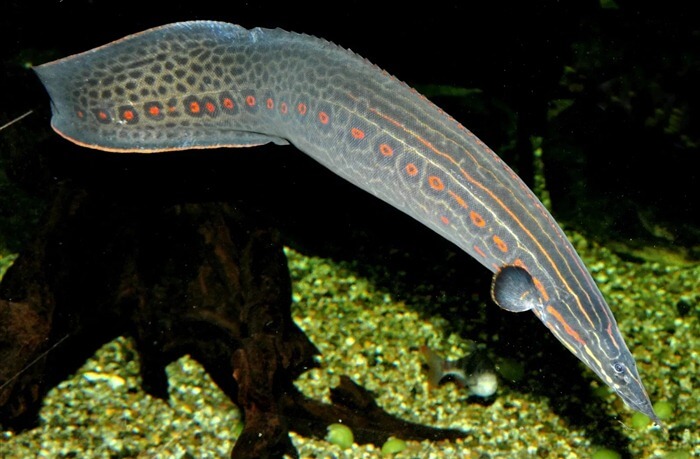 Mastacembla is a serpentine fish with an oblong body, which sometimes reaches 90 centimeters in length. These fish are long-lived, and sometimes they live for almost 20 years. Mastacembla lives mainly in fresh water bodies: in rivers, streams, lakes, swamps. It buries itself in the ground, where it tracks down its prey.
Mastacembla is a serpentine fish with an oblong body, which sometimes reaches 90 centimeters in length. These fish are long-lived, and sometimes they live for almost 20 years. Mastacembla lives mainly in fresh water bodies: in rivers, streams, lakes, swamps. It buries itself in the ground, where it tracks down its prey.
9. Betta fish "Cockerel"
 The cocktail fish is called a fighting fish for a reason: the reason for this is its cocky character. The aggressive behavior of males does not allow them to get along with other fish. Earlier in Asia there were even “fighting” tournaments between these fish.
The cocktail fish is called a fighting fish for a reason: the reason for this is its cocky character. The aggressive behavior of males does not allow them to get along with other fish. Earlier in Asia there were even “fighting” tournaments between these fish.
8. Lionhead fish
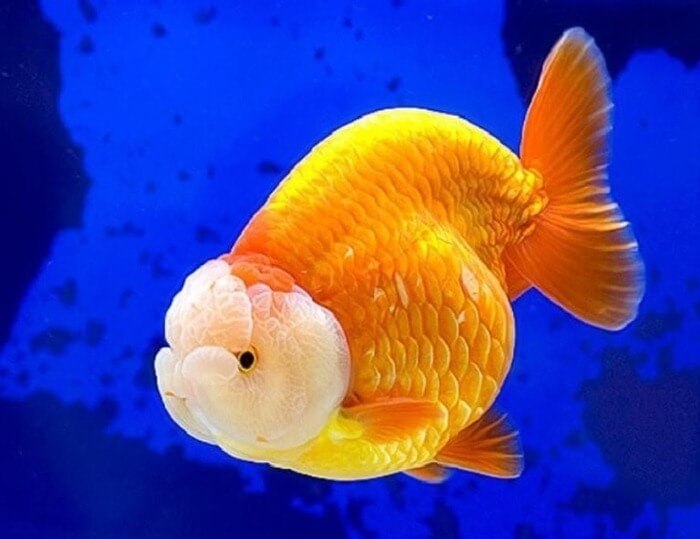 Lionheads are perhaps the most popular type of aquarium goldfish. Since these fish were bred by selection, they differ in a number of unusual features. The first is the absence of a dorsal fin. The second is a bizarre head with outgrowths. Unlike other goldfish, lionheads have a more rounded and ovoid body.
Lionheads are perhaps the most popular type of aquarium goldfish. Since these fish were bred by selection, they differ in a number of unusual features. The first is the absence of a dorsal fin. The second is a bizarre head with outgrowths. Unlike other goldfish, lionheads have a more rounded and ovoid body.
7. Butterfly fish
 The color of these fish really resembles butterflies: in nature there are various variations of the body pattern of these fish, but the most common color scheme is a combination of yellow, black and white colors with vertical stripes all over the body. Although butterfly fish belong to exotic inhabitants, they are familiar to almost all of us, because it is a favorite subject of filming of naturalist photographers.
The color of these fish really resembles butterflies: in nature there are various variations of the body pattern of these fish, but the most common color scheme is a combination of yellow, black and white colors with vertical stripes all over the body. Although butterfly fish belong to exotic inhabitants, they are familiar to almost all of us, because it is a favorite subject of filming of naturalist photographers.
6. Clown fish
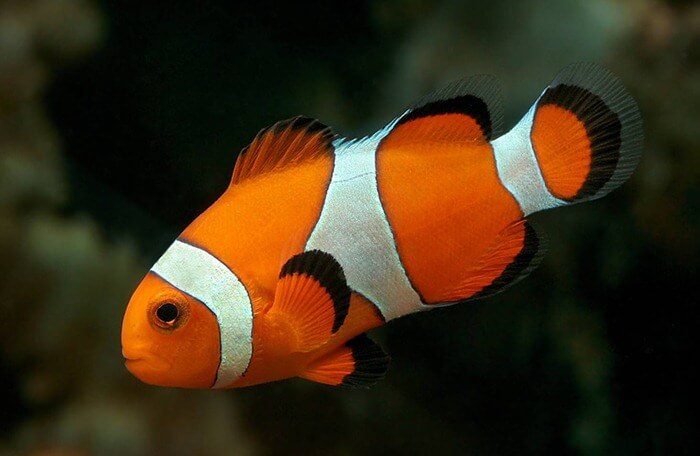 Another reference to the cartoon "Finding Nemo": the clownfish is the prototype of one of the main characters. Many consider this fish to be the most striking inhabitant of the sea depths - its bright orange color and contrasting white vertical stripes cannot but catch the eye. Fun fact: all clown fish are born males, and during life, an individual can change sex.
Another reference to the cartoon "Finding Nemo": the clownfish is the prototype of one of the main characters. Many consider this fish to be the most striking inhabitant of the sea depths - its bright orange color and contrasting white vertical stripes cannot but catch the eye. Fun fact: all clown fish are born males, and during life, an individual can change sex.
5. Parrot fish
 Parrot fish is a “product” of selection, so many of its physical characteristics are deviations. For example, its oblong mouth opens vertically at a shallow angle, making it difficult to feed. Also, the fish is sterile, therefore, they are not found in nature, but are only removed under artificial conditions by genetic scientists.
Parrot fish is a “product” of selection, so many of its physical characteristics are deviations. For example, its oblong mouth opens vertically at a shallow angle, making it difficult to feed. Also, the fish is sterile, therefore, they are not found in nature, but are only removed under artificial conditions by genetic scientists.
4. Seahorse
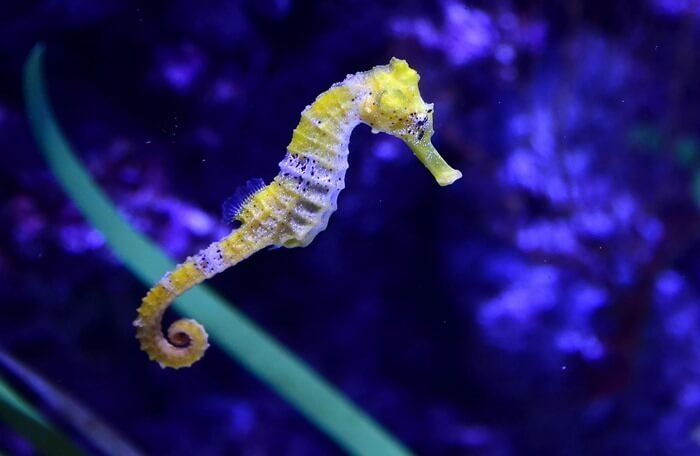 The seahorse actually resembles a horse with its bizarre shape, which makes it different from all other fish. The model of its movement is also specific - head up. The color of the seahorse accurately imitates the color and texture of the terrain on which it is located.
The seahorse actually resembles a horse with its bizarre shape, which makes it different from all other fish. The model of its movement is also specific - head up. The color of the seahorse accurately imitates the color and texture of the terrain on which it is located.
3. Two-color angel
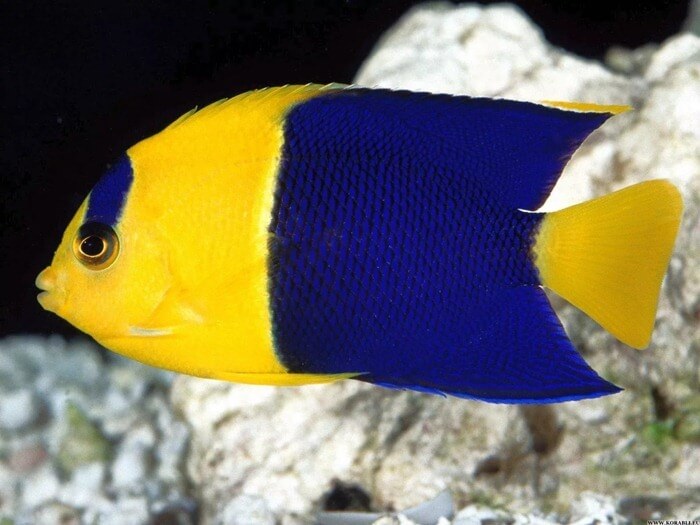 It is also called Centropig bicolor. The essence of the name lies in the color of this fish: on its body there is a clear border between bright blue and acid yellow, visually it looks so that the fish is divided into two equal colored parts. The two-color angel can be found in the waters of the Indian and Pacific Oceans. It should be noted that this species prefers to live at the very depths.
It is also called Centropig bicolor. The essence of the name lies in the color of this fish: on its body there is a clear border between bright blue and acid yellow, visually it looks so that the fish is divided into two equal colored parts. The two-color angel can be found in the waters of the Indian and Pacific Oceans. It should be noted that this species prefers to live at the very depths.
2. Imperial angel
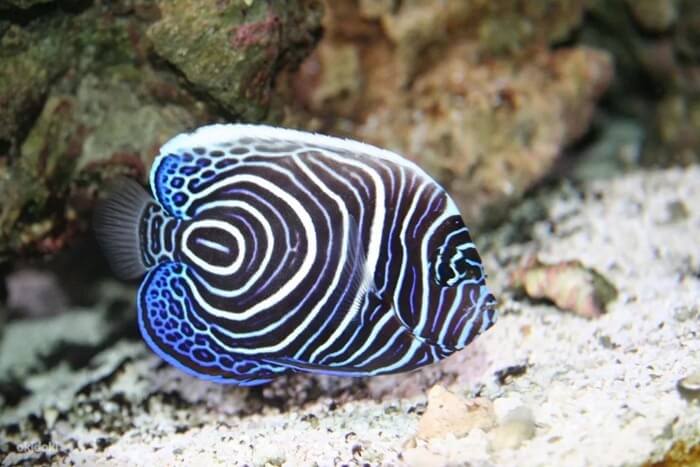 Imperial angels are some of the most beautiful coral fish that also change color throughout life. The litter contains a black body with white and blue concentric stripes. In adults, the body is bright purple with about 25 thin diagonal stripes of yellow-red color. With age, the skull becomes emerald above and red-brown below, with a characteristic bright mask around the eyes. "Ruler" lives near the coral reefs of the Indo-Pacific region.
Imperial angels are some of the most beautiful coral fish that also change color throughout life. The litter contains a black body with white and blue concentric stripes. In adults, the body is bright purple with about 25 thin diagonal stripes of yellow-red color. With age, the skull becomes emerald above and red-brown below, with a characteristic bright mask around the eyes. "Ruler" lives near the coral reefs of the Indo-Pacific region.
1. Tulle apogee
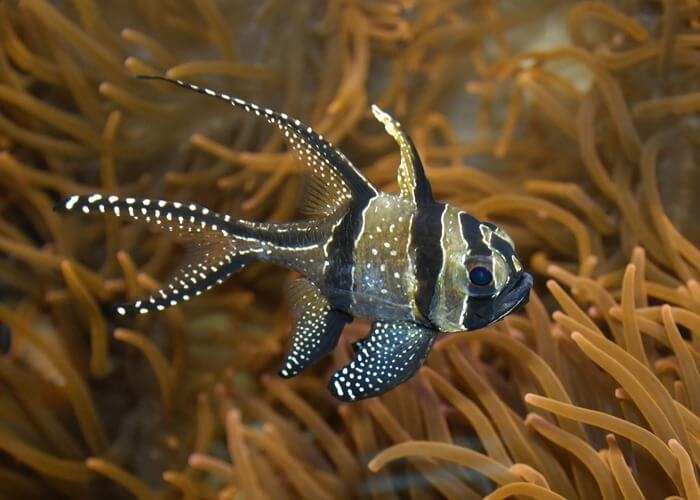 A distinctive feature of the apogons are high branched fins and bright coloration, mainly of warm colors. They are not picky and can live in both sea and fresh water. These fish are very "sentimental": before breeding, individuals groom each other.
A distinctive feature of the apogons are high branched fins and bright coloration, mainly of warm colors. They are not picky and can live in both sea and fresh water. These fish are very "sentimental": before breeding, individuals groom each other.
The beauty of exotic fish explains the desire of many people to establish an aquarium in their home or workplace. And today it is much easier to do this than before: after all, almost all the means for caring for even the most fastidious species are easily accessible. But because of such popularity, poaching is gaining momentum, which puts many breeds on the brink of extinction.

